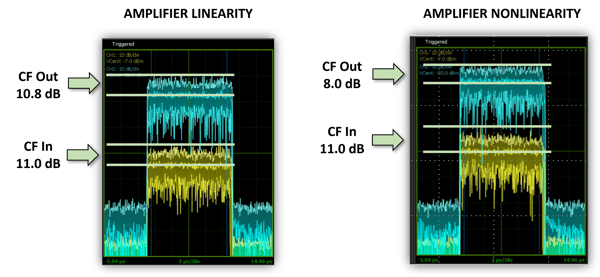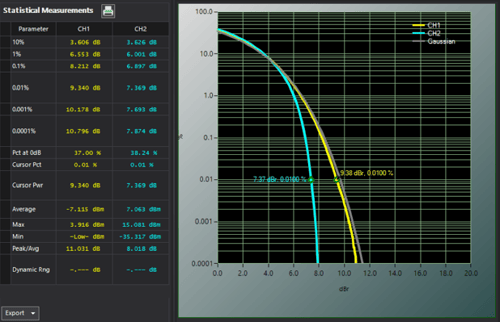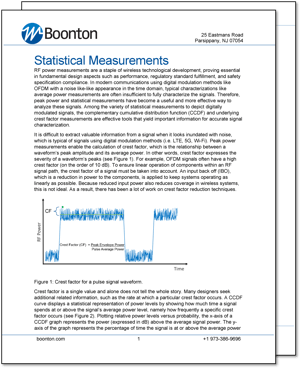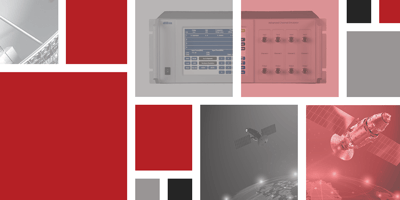Time division duplex (TDD) is a favorable scheme for 5G. Uplink and downlink transmissions occur on...
How Can Crest Factor Be Used to Assess Amplifier Linearity?
Crest factor (CF) is the ratio of a signal's peak amplitude to its average power. Also called the peak-to-average-power ratio (PAPR), CF reveals a signal’s extreme peaks. Analyzing an amplifier's input and output CF values can validate linear operation or determine nonlinearities in the system.
This post explores the CF method as an assessment for amplifier linearity as well as important peak power sensor considerations.
Amplifier Linearity: Crest Factor Method
The CF method starts with a band-limited additive white Gaussian noise (AWGN) waveform, which is used to represent several carrier signals. A peak power sensor measures the CF of the AWGN signal after it passes through a directional coupler or signal splitter.
The AWGN signal is then applied to the amplifier under test and a peak power sensor is ready and waiting to capture the CF of the output. These two CF values at the input and output of the amplifier are the crux of the linearity assessment. The video below depicts this measurement setup.
💡Head over to Noisecom to find an ideal, high-performance, customizable noise source best suited for your needs.
Engineers carefully compare the input and output CF figures. If the two values diverge from each other, meaning the output CF reduces in response to an increase in input power, then the amplifier has clipped the most extreme peaks of the waveform, indicating nonlinearities.

Instead of just observing the highest data point, the complementary cumulative distribution function (CCDF) provides a statistical analysis of CF values. This graph plots the percentage of time that a signal is equal to or greater than its average power by a specific ratio. That power ratio, as measured on the CCDF curve, becomes the CF as the percentage of time approaches zero. In the example shown below, the CF is where the CCDF curve crosses the x-axis.

Crest Factor Method Advantages
CF isn’t the only way to characterize amplifier linearity. Alternatives include the noise power ratio (NPR) method and analyzing 3rd order intermodulation products. Compared to other approaches, the CF method has several advantages, including:
Accurate Results: Peak power sensors provide a true understanding of compression and deliver more accurate measurements than spectrum analyzers.
Cost Efficiency: Utilizing AWGN sources and peak power sensors saves the expense of purchasing higher-priced test instrumentation.
User-friendly Operation: CF method products are easy to operate, which greatly reduces the risk of introducing user-caused errors into the results.
Peak Power Sensor Essentials
There are a few characteristics of peak power sensors that must be considered for reliable measurements, one of which is video bandwidth (VBW). VBW depicts whether a sensor can follow a signal's variations in amplitude, (i.e., its envelope power).
To avoid distortion and flawed measurements, a peak power sensor's VBW must be wide enough to accommodate the AWGN signal's bandwidth. The sensor also needs the necessary speed to track the signal's rising edge.
Peak power sensors are ideal test instruments due to their wide VBW and fast rise times. For example, Boonton RTP5000 Series Real-time USB Peak Power Sensors, backed by Real-time Power Processing TM (RTPP) technology, have 195 MHz of VBW and extremely quick rise times that are less than 3 nanoseconds.
How is this possible? Two factors come into play. First, a low impedance load across smoothing capacitors enables peak power sensors to discharge rapidly when there is a drop in RF amplitude. Second, peak power sensors have a small smoothing capacitance.
Learn More
For more information on CF measurements, read through two interesting articles from Boonton – “Boonton’s Wi-Fi-6 Solutions: Crest Factor and CCDF” and “Statistical Measurements.”
Need a refresher on amplifier linearity fundamentals? You’re in luck. We have a blog post that goes over the basics of amplifier linearity, amplifier efficiency, and various measurement methods.



Amplifier linearity is crucial to maintain high-fidelity communications. Boonton has a trove of additional insight on high-performance solutions like the RTP5000 Series sensors, which are excellent instruments for CF measurements and linearity analysis.



